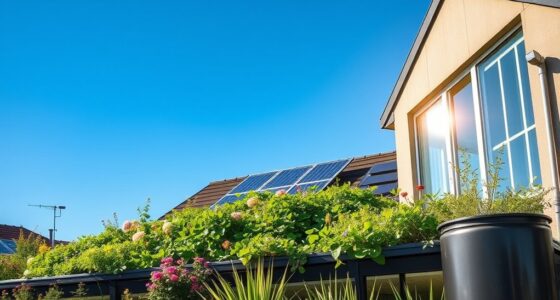Thinking about switching to solar power? Before you make any decisions, it’s important to evaluate if your home is truly ready for solar panels. From sunlight exposure to your roof’s condition, there are several key factors that can influence your system’s efficiency and cost-effectiveness. Taking the time to assess these areas now can save you money and hassle later—so, let’s explore what it takes to prepare your home for solar energy.
Evaluating Your Home’s Sunlight Exposure
Before installing solar panels, you need to assess how much sunlight your home receives. Start by observing your property during different times of the day and throughout the year. Notice if trees, buildings, or other objects cast shadows on your roof or yard. Clear, unobstructed sunlight is essential for maximizing your system’s efficiency. Additionally, consider the best hot rollers for long hair to understand how different factors affect the overall performance of your solar setup. Keep in mind that the direction your roof faces impacts sun exposure; south-facing roofs typically get the most sunlight in the northern hemisphere. Also, consider the angle of your roof—steeper angles can gather more sunlight. To get a more precise measurement, you can use sun mapping tools or solar pathfinders. This initial assessment helps determine if your location is suitable for solar energy and how much energy you can expect to generate.
Assessing Your Roof’s Suitability for Solar Panels
To determine if your roof can support solar panels, start by inspecting its condition and structure. Look for signs of damage, such as missing shingles, rot, or sagging areas, which may need repairs before installation.
Check the roof’s material—most solar panels work well with asphalt shingles, metal, or tile.
Ensure your roof has a sufficient lifespan; panels typically last 25-30 years, so a roof less than 10-15 years old is ideal.
Evaluate the roof’s orientation and tilt—south-facing roofs generally receive the most sunlight.
Also, consider shading from trees or nearby buildings, as shading can reduce energy production.
Assessing the roof’s structural integrity is essential, as it impacts the long-term safety and stability of your solar panel system.
If your roof is in good shape and properly oriented, it’s a strong candidate for solar panel installation.
Understanding Your Energy Consumption and Needs
Have you ever wondered how much energy your household uses or what your daily consumption looks like? Knowing this helps determine the size of the solar system you need.
Check your electricity bills over the past year to find your average monthly usage, usually measured in kilowatt-hours (kWh). Pay attention to seasonal fluctuations, as energy needs can vary throughout the year.
Identify which appliances or devices consume the most energy, like HVAC systems, refrigerators, or water heaters. This understanding helps you decide whether you want to offset your entire bill or just a portion of your consumption.
Understanding your overall energy consumption is also essential for evaluating your home’s readiness for solar installation and making informed decisions about system size and capacity.
Exploring Solar Incentives and Financial Options
Understanding your energy consumption helps you plan a solar system that fits your needs, but it’s also important to consider the financial aspects. Solar incentives, like federal tax credits, can significantly reduce your upfront costs.
Many states and local governments offer rebates or additional incentives that can further lower your investment. Additionally, you might explore financing options such as solar loans, leases, or power purchase agreements (PPAs). Each has pros and cons, so choose what aligns best with your financial situation.
Don’t forget to check if your utility offers net metering, which allows you to earn credits for excess energy your system produces. Taking advantage of these incentives and financial options can make switching to solar more affordable and appealing.
Considering the available solar IRA options, you might also explore how solar investments can be integrated into your retirement planning.
Preparing for the Installation Process
Are you ready to move forward with your solar installation? Before the work begins, take a few key steps to prepare.
Clear the area around your home’s roof or yard where panels will be installed, removing any obstacles like branches or debris.
Ensure your roof is in good condition and can support the weight of the panels; you might need a roof inspection.
Communicate with your installer about access points and any necessary permissions.
Verify that you have all required documentation, such as permits or approvals, in hand.
Finally, arrange for someone to be home during installation, or plan to be available for questions.
Understanding home readiness can help you anticipate potential issues and ensure a smooth installation process.
Proper preparation helps the process go smoothly and reduces delays.
Maintaining and Maximizing Your Solar System
Regular maintenance is key to keeping your solar system operating at peak efficiency. You should regularly inspect your panels for dirt, dust, or debris, which can block sunlight and reduce energy output. Cleaning the panels with water and a soft brush or cloth keeps them clear without risking damage. Additionally, understanding projector technology can help you better assess and optimize your system’s performance. Check for any signs of damage, such as cracks or corrosion, and ensure all connections are secure. Monitoring your system’s performance through your inverter or a dedicated app helps identify drops in efficiency early. Trim nearby trees or bushes that cast shadows on your panels. Scheduling annual professional inspections can catch issues you might overlook. Proper upkeep ensures you maximize energy production, extend your system’s lifespan, and get the most value from your solar investment.
Conclusion
Getting your home ready for solar panels is a smart move that pays off in the long run. By assessing sunlight, ensuring your roof’s in good shape, and understanding your energy needs, you can maximize your system’s efficiency. Don’t forget to explore incentives and plan the installation carefully. With proper preparation, you’ll enjoy clean, renewable energy and lower bills. Take these steps now to make your solar journey smooth and successful.




